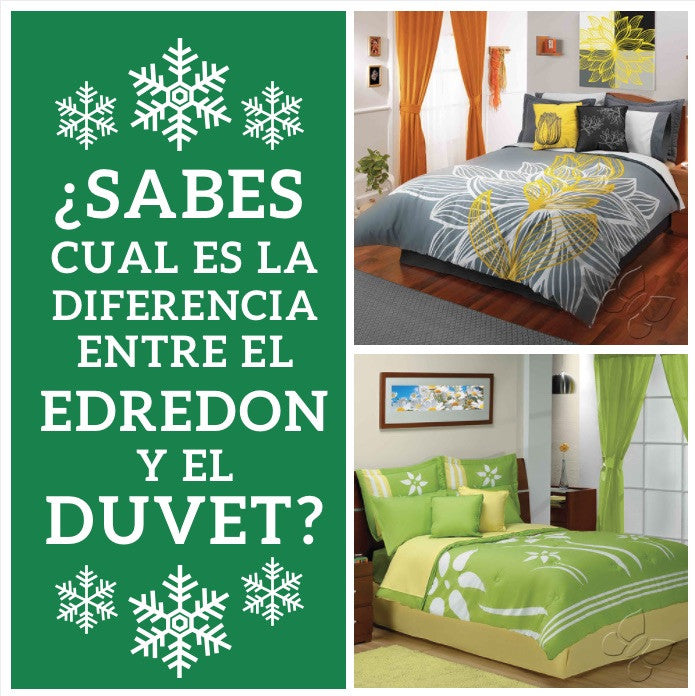
Do you know what the difference is between a comforter and a duvet? Find out!
The comforter and the duvet are not the same. Do you want to know the differences, their advantages and disadvantages? Find out all about it in this revealing article!
The cold is already beginning to be felt in homes and what we have to do is inspect the attics of the closets in search of comforters, duvets and other bedding that makes us feel warmer. In this article, we discover the differences between the comforter and the duvet, the 3 types of duvets there are and which is the best choice to spend the most comfortable winter possible.

The difference between the comforter and the duvet
A duvet is, so we understand each other, a type of quilt filled with feathers, wool, fiber or other materials with the aim of providing warmth on cold nights. You will recognize it because it is a single piece, that is, it is sewn and the component that provides shelter is inside and cannot be separated. As you may have guessed, then, it is easy to arrange on the bed since you don't have to try to spread it out to make it neat. The duvet keeps the filling evenly distributed and avoids cold, unsheltered areas.
At Intima Hogar we have a large catalog of duvets of different colors and motifs so you can find the one that best suits your needs and tastes. Also, a great advantage is that the duvet is cheaper than the duvet.
A duvet consists of two parts: on the one hand, the duvet filling and, on the other, the cover that covers it. For its part, the interior of the duvet is presented in white fabric, since it is designed to be covered with a cover (this one already has the design of your choice) that will give your room a different touch.
Precisely, one of the main advantages of the duvet over the duvet is that putting it in the washing machine is a much simpler task, since you only have to wash the cover and not all of the filling. Intima Hogar duvets always include the cover.
The difference between fillers: advantages and disadvantages
There are two types of duvet or comforter filling and we are going to tell you their advantages and disadvantages.
- Natural fiber fillings such as goose down, duck or goose feathers, wool, silk or cotton are seen as a luxury option, as they are soft, light and comfortable but tremendously expensive. The price of these pens starts at $300 and can reach $1,000 or more. If properly cared for, natural materials have a lifespan of 10 to 20 years. This reminds me of the story of a friend of mine who saved up to buy a goose down duvet. She was in love with that duvet and the down did last long, but the same did not happen with the fabric that covered it. After a few years the fabric began to open and the soft feathers began to come out and fly all over the room. He patched it up as much as he could because it had really cost him a lot of money and he didn't want to throw it away. However, when he patched one hole, another opened and the feathers continued to come out and stick to the walls, his clothes, and the floors. With a heavy heart he finally had to get rid of it.
- Filled with synthetic fiber . A common misconception is that a duvet or duvet made of synthetic fibre, that is, filled with 'hollow fibre' or 'microfibre', will be colder and less effective than a natural duvet filled with goose down. This is simply not the case. Microfiber-filled comforters or duvets are less expensive than down-filled ones and last about 10 years. They are hypoallergenic, so they are especially good for those who suffer from allergies such as asthma, eczema, rhinitis, or those sensitive to dust. Intima Hogar's duvets and duvets are made of polyester, such as 'hollow fiber'. Microfiber is the ultimate in fiber filling and gives us the closest feeling to down as they are extremely light and wonderfully soft.
Note for those who suffer from allergies:
Allergies are generally the result of dust and dirt collected on the duvet, not the down itself, with exceptions, of course. You don't have to be allergic to birds to be allergic to a feather duvet. Allergies to dust and the mites that grow there are the source of the most common respiratory problems.
Fiber fillings are a good alternative since they are soft and warm and can be washed frequently in addition to being accessible to all pockets. Intima Hogar duvets and comforters are filled with soft, hypoallergenic microfiber, resistant to dust mites, and can be washed at 140°F (60°C), the temperature that kills these mites. All comforter sizes fit perfectly in a standard household washing machine.
Now that you know the difference between a comforter and a duvet, take a look here at the beautiful designs we have to dress your home this season!

Comments (4):
Intima on
Mil gracias Enrique!! :)
Enrique Muñoz on
Muy buena explicación me gustó realmente
Intima on
Buenas Adriana,
Puedes ver los precios mayoristas afiliandote a Intima. Cualquier duda que tengas, llámanos o enviarnos un mensaje.
Adriana Rangel on
Precio de duvets y fundas
Leave a comment:
Other articles:
Quick links
Customer Support
How does it work
Testimonials
Returns/Exchanges
Frequent questions
Intimate Blog
terms and Conditions
Privacy Policy
Cookies policy
You are in Mexico?
Contact us
About Intima Hogar
We are a company with more than 40 years in the white goods market. We sell the best Coverlets, Bedspreads and Duvets on the market and offer the opportunity to start a business selling our products.
© Copyright 2025
Intima
